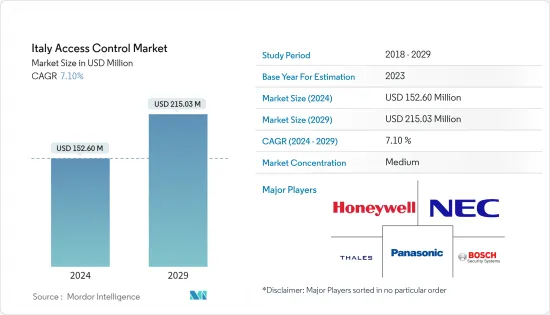Need help finding what you are looking for?
Contact Us
PUBLISHER: Mordor Intelligence | PRODUCT CODE: 1549975

PUBLISHER: Mordor Intelligence | PRODUCT CODE: 1549975
Italy Access Control - Market Share Analysis, Industry Trends & Statistics, Growth Forecasts (2024 - 2029)
PUBLISHED:
PAGES: 90 Pages
DELIVERY TIME: 2-3 business days
SELECT AN OPTION
The Italy Access Control Market size is estimated at USD 152.60 million in 2024, and is expected to reach USD 215.03 million by 2029, growing at a CAGR of 7.10% during the forecast period (2024-2029).

Key Highlights
- Access control devices are components that are used in access control systems to enforce rules and regulations regarding the entry and exit of individuals. These devices play an important role in maintaining the security and integrity of a premises or system. Locks are fundamental devices in access control systems as they control the physical security of entrances.
- Card readers are devices that read access cards or key fobs to grant or deny access to individuals. These devices are often used in conjunction with authentication methods such as passwords or biometric analysis. Biometric devices use unique physical or behavioral characteristics, like facial recognition or fingerprints, to verify the identity of individuals and grant access.
- The Internet of Things (IoT) has increased the efficiency and standard of automation systems by enabling secure data exchange and tying smart objects to the Internet. Remote monitoring of key areas is made possible by cloud-based communication between connected security systems and devices. Additionally, the use of password authentication to thwart hacking makes IoT-based security systems secure. Because IoT can be used in a variety of solutions, such as smart alarm systems and smart garage door openers, it is replacing many businesses' traditional processes.
- Additionally, security systems that are cloud-based and mobile are becoming a superior choice. Mobile credentials provide a more convenient and secure alternative. Since people frequently carry their mobile phones with them wherever they go, access control devices have naturally developed for this market. Mobile access control also has remote functionality. For instance, after being alerted by an apartment intercom system, a tenant can grant access to a visitor from a mobile app on their phone.
- Cloud-based access control is intuitive to use and offers the most flexibility for administrators. Access credentials can easily be granted or revoked from any device or location. User authorization, access points, and data trends are centralized in a single, remotely accessible database.
- This is a significant advancement in the physical security industry as it eliminates the need for an on-site IT professional to manage the system. Another significant benefit that has helped fuel the growing popularity of cloud access control is scalability. Facility and property managers who manage security at multiple sites can easily manage their databases from one location. From protecting the perimeter to securing high-value assets, access control systems are a fundamental responsibility for organizational security departments.
- Several market players are collaborating with each other to enhance their market share. For instance, in May 2024, Ermessrl, one of the prominent players providing solutions for the identification and security of people, signed a distribution agreement with Zwipe, a pioneer in the development of biometric technology on cards for identification, access control, and payment. According to this partnership, Ermessrl agreed to distribute Zwipe's biometric access cards in Italy. ZwipeAccess utilizes advanced biometric capture and matching technology to securely store the cardholder's encrypted fingerprint template directly within the card's smart chip during issuance.
- However, the lack of awareness about security solutions and the high prices associated with access control devices can be significant restraints to the growth of the studied market. The cost of implementing access control systems, including hardware, software, and installation, can be a barrier for some organizations, especially smaller businesses or budget-constrained entities.
- Additionally, the complexity of integrating access control devices with existing systems can pose a challenge. Organizations may need help in seamlessly integrating access control devices with their current infrastructure, leading to delays or complications in implementation.
- Also, the conflict between Russia and Ukraine will significantly impact the semiconductor industry. The conflict has already exacerbated the electronics and semiconductor supply chain issues and chip shortages that have affected the industry for some time. The disruption may result in volatile pricing for critical raw materials such as nickel, palladium, copper, titanium, and aluminum, resulting in material shortages. This, in turn, could impact the manufacturing of access control devices.
Italy Access Control Market Trends
The Biometric Readers Segment is Expected to Drive the Market's Growth
The Commercial Segment is Expected to Witness a Higher Growth Rate in the Market
Italy Access Control Industry Overview
Additional Benefits:
Product Code: 50002626
TABLE OF CONTENTS
1 INTRODUCTION
- 1.1 Study Assumptions and Market Definition
- 1.2 Scope of the Study
2 RESEARCH METHODOLOGY
3 EXECUTIVE SUMMARY
4 MARKET INSIGHTS
- 4.1 Market Overview
- 4.2 Industry Attractiveness - Porter's Five Forces Analysis
- 4.2.1 Threat of New Entrants
- 4.2.2 Bargaining Power of Buyers/Consumers
5 MARKET DYNAMICS
6 TECHNOLOGY SNAPSHOT
7 MARKET SEGMENTATION
8 COMPETITIVE LANDSCAPE
9 INVESTMENT ANALYSIS
10 FUTURE OF THE MARKE
Have a question?


SELECT AN OPTION
Have a question?


Questions? Please give us a call or visit the contact form.
